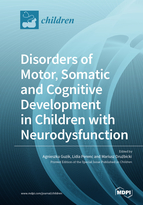Disorders of Motor, Somatic and Cognitive Development in Children with Neurodysfunctions
A special issue of Children (ISSN 2227-9067). This special issue belongs to the section "Child Neurology".
Deadline for manuscript submissions: closed (20 November 2020) | Viewed by 41872
Special Issue Editors
Interests: postural stability; balance; gait analysis; physiotherapy; musculoskeletal rehabilitation; neurorehabilitation; stroke
Special Issues, Collections and Topics in MDPI journals
Interests: Anthropometry; somatic growth; cognitive and social development; health behaviors
Special Issue Information
Dear Colleagues,
Dysfunctions in a child’s nervous system may be caused by numerous factors: genetic, contagious physical, chemical, or environmental. The prevalence of neurodysfunctions in pediatric populations is relatively high, compared to defects of other systems. This is linked to the fact that the development of the specific structures of the nervous system occurs over a relatively long period of time, during which the processes are affected by harmful factors. It may be difficult to accurately identify the cause, even in half of the children affected by the condition. The dysfunctions of the nervous system may have an impact on locomotion, somatic growth, and cognitive and social development. Therefore, children and adolescents with neurodysfunctions require continuous, comprehensive rehabilitation, covering not only motor functions but also mental and social ones. We invite the submission of original research manuscripts as well as review articles and case studies that address somatic, motor, and cognitive development disorders in children and also those that address neurorehabilitation in children with neurodysfunctions.
We look forward to receiving your submissions for this Special Issue.
Dr. Agnieszka Guzik
Prof. Dr. Lidia Perenc
Prof. Dr. Mariusz Drużbicki
Guest Editors
Manuscript Submission Information
Manuscripts should be submitted online at www.mdpi.com by registering and logging in to this website. Once you are registered, click here to go to the submission form. Manuscripts can be submitted until the deadline. All submissions that pass pre-check are peer-reviewed. Accepted papers will be published continuously in the journal (as soon as accepted) and will be listed together on the special issue website. Research articles, review articles as well as short communications are invited. For planned papers, a title and short abstract (about 100 words) can be sent to the Editorial Office for announcement on this website.
Submitted manuscripts should not have been published previously, nor be under consideration for publication elsewhere (except conference proceedings papers). All manuscripts are thoroughly refereed through a single-blind peer-review process. A guide for authors and other relevant information for submission of manuscripts is available on the Instructions for Authors page. Children is an international peer-reviewed open access monthly journal published by MDPI.
Please visit the Instructions for Authors page before submitting a manuscript. The Article Processing Charge (APC) for publication in this open access journal is 2400 CHF (Swiss Francs). Submitted papers should be well formatted and use good English. Authors may use MDPI's English editing service prior to publication or during author revisions.
Keywords
- neurodysfunctions
- neurorehabilitation
- gait
- anthropometry
- somatic growth
- cognitive and social development
- health behaviors








